Hidden Creek Golf Club
NJ, USA
Green Keeper: Jeffrey Riggs
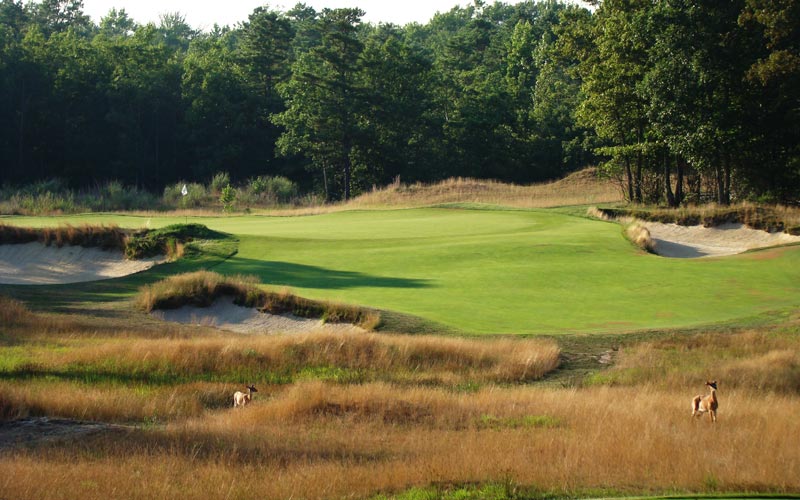
The richly textured Hidden Creek holds its head high in a state blessed with many classical courses built during the Golden Age of golf course architecture.
Many factors go into the creation of a ‘great’ course, with great defined as a course that one wishes to play numerous times, year after year. Three primary ones are the site needs to be special, the driving force behind the project must understand and look to promote golf as being about enjoyment and variety and then finally, the architect has to deliver a strategic design. Getting all three factors to come together at the same time is difficult or otherwise there would be many more great courses. Hidden Creek in southern New Jersey is a rare example of a modern course where the key ingredients seamlessly melded together, though from the time that the owner first contacted the architects to when this dream course opened was seventeen years!
To start with, the owner of Hidden Creek, Roger Hansen, grew up outside of Atlantic City, New Jersey where he gained an appreciation of classic architecture at Atlantic City Country Club, the two courses at Seaview Country Club and then later at Pine Valley Golf Club. In 1985, having read an article in a golf magazine where Ben Crenshaw expressed an interest in designing courses, Hansen called Ben Crenshaw. At the end of the lengthy telephone conversation, Ben Crenshaw encouraged him to contact a man named Bill Coore. Having done so, Hansen eventually flew down to tour Coore’s Rockport Country Club in Corpus Christi with Coore in December, 1986. The two men hit it off and Roger Hansen knew whom he would select should he ever get into the golf course business.
A few years passed and in 1991, Roger Hansen decided to develop two public access courses in Galloway Township. He contacted the now existing architect firm of Coore & Crenshaw and had Coore come see the site. Ultimately, Coore & Crenshaw politely declined the project as they were tied up in Hawaii with the design of the Plantation Course at Kapalua. Nonetheless, Hansen pursued his vision and the resulting Stephen Kay and Steve Smyers courses were an immediate success with the Smyers course hosting the U.S. Public Links Championship in 2003.
A few more years pass and it is now the fall of 1998 when Roger Hansen becomes aware of another large block of property twelve miles from Atlantic City. This time, he was surprised/delighted to find that the site has up to fifty feet in elevation change with consistent movement throughout the upland part of the property. Thus, he contacts Bill Coore and Ben Crenshaw again. With a little arm twisting, he convinces Bill Coore that the site does indeed hold promise and to return to south New Jersey to see for himself.
Once there, Bill Coore stays, walking and re-walking the property. The clubhouse needed to be located within 1000 feet of the entrance drive to avoid seeking a state permit to improve the roadway, the timing of which would have delayed the project for at least one year. Apart from the location of the clubhouse, Hansen gave Coore carte blanche to go anywhere that he wanted on the expansive 750 acres. After three weeks, and on one occasion having wandered off the property and stumbled onto a shooting range (!), Coore had seen enough and flew back to Texas.
Coore and Crenshaw discussed the matter and replied to Hansen that they could build a course that would be reflective of the site’s charms. Roger Hansen accepted their terms and work commenced in the summer of 2000. Think about it – Bill Coore spent three weeks on site before Coore & Crenshaw had a signed contract. That is more time than 90% of the big name architects spend on site after they get a signed contract!
With only a couple of modifications on the back side, the final routing was the one that Coore visualized during his three week stay with Roger Hansen. He decided that none of the 300 acres of wetlands would feature into the design and that the holes would stay on the upland part of the property which possessed the natural movement and land forms. Coore’s routing stands out in excellence because it perfectly exposed the rolls of the property through one engaging hole after another while at the same time minimizing any green to tee walks. The end result is that only 50,000 cubic yards of dirt were moved during the project and that the course is reflective of the ground upon which it sits.
As Coore says, ‘The Hidden Creek site required very little alteration to the landscape. The holes lay on the ground pretty much the way we found it. That’s consistent with the way Ben and I like to work…We look for projects in which the site lends itself to golf in its natural form. Hidden Creek looked like golf in its natural form in terms of rolling terrain and trees. Since the fairways required minimal movement of earth, it enabled us to emphasize details, such as bunkers and the contouring of greens.’
With the routing in place, James Duncan, who has a background in civil engineering and who had joined Coore & Crenshaw in 1998 for the East Hampton Golf Club, was brought in as Project Manager. One of his first tasks was to oversee the tree clearing and with the design team having sensed a chance to build a course similar in feel to the heath courses in England, large playing corridors eighty plus yards in width were created. The concept of building a course with a similar appeal to the heath courses gathered additional steam when it was realized that some of the vegetation underneath the trees that border the playing corridors was actually called false heather.
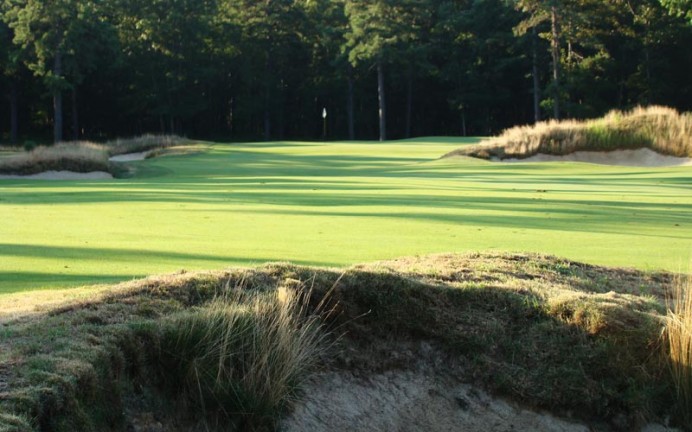
A game at Hidden Creek evokes the appealing rustic qualities of the heath courses outside of London.
With the tree clearing complete in September 2000, the construction of the holes commenced. Jeff Riggs, the Green Keeper at Roger Hansen’s nearby Blue Heron Pines Golf Club, was brought on board full time at this point. With Coore & Crenshaw’s Jim Craig and Dave Zinkhand on site and Jeff Bradley coming down from Friar’s Head on a regular basis, the core team was in place. Dan Proctor and Tom Beck would later play key roles in finishing the course as well.
As with any course, integral to the lasting enjoyment by its members would be a series of interesting green complexes. Not wanting to be tied to the USGA green construction method which has limitations in tying in the green with its surrounds, the greens were constructed as follows: the existing sandy, gravelly soil was pulled back from a large area (say 13,000 square feet) from where the green would approximately be located. Clean sand was brought in to fill up the hole to grade level. Coore & Crenshaw deliberated green by green as to what each green’s playing characteristics should be and then Jim Craig worked his magic in creating just such greens. Green mix was then applied. One great advantage to this method is that there isn’t a defined break in the types of soils and playing conditions as one approaches the green; there is a gradual transition making the ground game a genuine – and often preferred – way to approach the green.
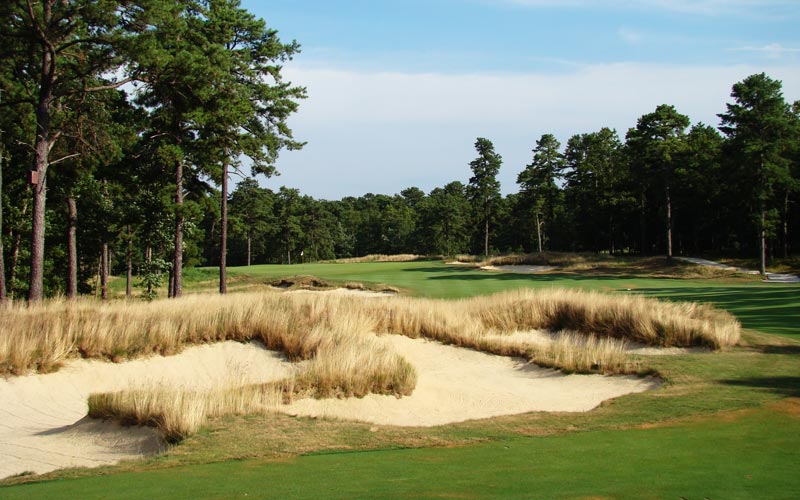
This bunker complex in the landing area of the twelfth fairway is indicative of the hand work that went into Hidden Creek’s construction.
Much detail work went into the construction of Hidden Creek, in part because Coore & Crenshaw weren’t bouncing around the country tending to twelve different projects at once. Rather, they were adhering to their philosophy of two projects per year with the other being Friar’s Head on eastern Long Island. Nothing was rushed at Hidden Creek, allowing each man to take great pride in his own handy work. As a result, the course enjoyed a sense of instant maturity the day it opened in June 2002 and since then as only evolved for the better thanks to the work of Riggs working with the fescues and native vegetation and seeking to get the fairways running hot.
Holes to Note
First hole, 400 yards; Some first holes like the ones at Yale Golf Club, Sand Hills Golf Club, and Pinehurst No. 2 inform the player right away if he is going to like the course as the holes are indicative of what lies ahead. The same holds true at Hidden Creek. From the moment that one leaves either the nearby putting green or the practice field and steps onto the tee, all one sees is a pure golf landscape. There are no homes or paved cart paths, the playing corridor and fairway are wide, the green is large at 8,000 square feet but with hole locations best accessed from certain sides of the fairway, and the fescue grasses provide great visual contrast.
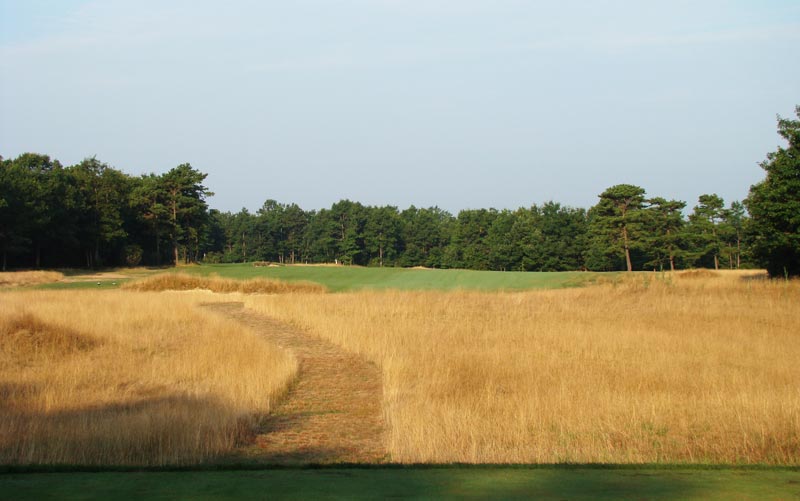
The wide cut though the fescue signifies that everything is done to encourage walking at Hidden Creek, from caddies to pull carts to motorized pull carts to carrying one’s own bag.

Slightly raised from its surrounds and only bunkered on one side, there are many ways to turn two shots into three around the first green.
Second hole, 370 yards; Wide fairways in and of themselves aren’t strategic. If the bunkers at The Old Course at St. Andrews paralleled the fairways as opposed to being down the line of play, then The Old Course would be infinitely more boring. Instead, thanks to the random placement of central hazards throughout the course, The Old Course remains a strategic gem in any wind. Same for Hidden Creek as Coore & Crenshaw were quick to create central hazards and diagonal carries throughout the course. Of particular note too is the ferocious bunker eleven paces from the front right edge of the green, the wall of which is eight feet high. Bill Coore and Jeff Bradley had great fun planting then ripping out clumps of grass and dirt to give this bunker its look.
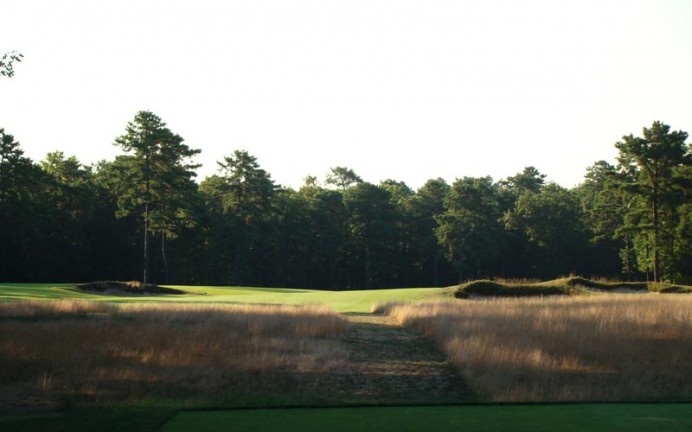
The bunker in the left middle of the second fairway provides the strategic interest on the tee shot.
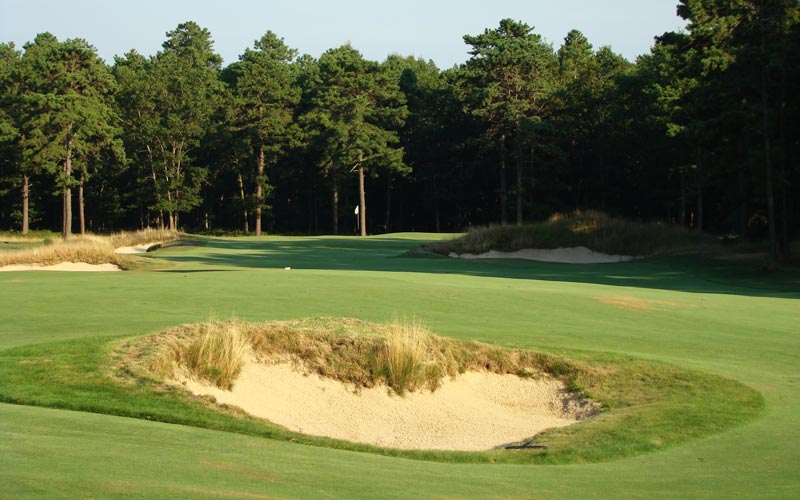
Cut into the ridge that runs down the fairway, this central bunker is surrounded by fairway and requires a 255 yard carry from the back markers. The benefit in carrying it is that the golfer won’t have to contend with the awe inspiring bunker that blocks the view of the green from the right side of the fairway.
Third hole, 535 yards; Hidden Creek is twelve miles west of the Atlantic Ocean and as such, the wind is always a factor, though how much is tricky to judge as few consecutive holes head in the same direction. For the third hole in a row, Bill Coore leads the golfer in a completely different direction and he did so in part to take advantage of an abandoned quarry where sand and gravel were once excavated for use in a nearby road construction project. This abandoned pit is approximately one hundred and sixty yards long by fifty yards wide and eight feet deep and was the site’s most unique feature. Coore & Crenshaw wisely placed the green some twenty yards beyond this formidable pit as by so doing, they tempt many more class golfers into having a go at the green in two, wind permitting.
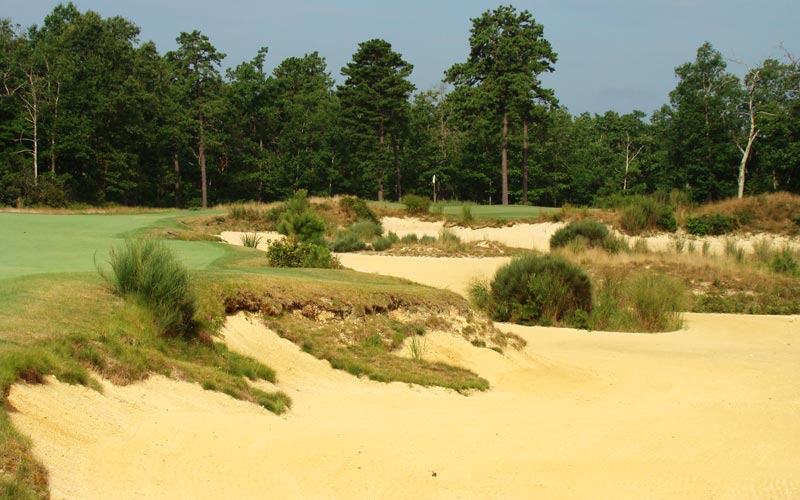
Trying to carry this one hundred and sixty yard quarry and reach the third green in two is a thrilling shot.
Fourth hole, 220 yards; A breathtaking hole, with immediate comparisons belonging with the all-world Long Redan fourth at Riviera and the Long Reverse Redan eleventh on The North Course at Los Angeles Country Club. The design team opted to clear a large area of trees well behind the green to help give the hole the same sense of drama and scale as one experiences when standing on the tenth tee of The Old Course at Sunningdale. Similarly, they also cleared a large area behind the sixth and twelfth greens, which, in addition to giving those holes an expansive feel, also provides for improved air flow and sunlight for the greens.

George Thomas would be thrilled by this glorious version of a long Redan with the golfer soaking up the view from the elevated tee of seeing his tee ball release right to left across the immense 9,400 square foot green. The covered mounds behind the green represent the dirt that was pulled back in the creation of the green complex.
Fifth hole, 395 yards; A modern day architect has many tricks up his sleeve to challenge the golfer. Some ways aren’t so subtle like forced carries over water (by the way, there are no water hazards at Hidden Creek) and others are subtle, like creating depth perception problems. In the case of the bunkerless fifth, rather than cutting a bunker into the slope at the right front of the green, Coore & Crenshaw brought in piles of dirt and built a feature that obscures much of the putting surface. Where Coore & Crenshaw excel is in making a man-made hazard like these mounds appear natural by having them be irregular and haphazard in appearance which is in stark contrast to other modern architects who create heinously uniform and symmetrical features. Remember: There is nothing uniform in nature so features shouldn’t be either. As it relates to the playing quality of this hole, the green is the second deepest one on the course at 48 yards and without a good view of the putting surface, good players struggle in gauging the right distance for their approach shots, especially to the back hole locations.

The fifth fairway is a hog’s back with balls being kicked both left and right. However, unless the golfer finds the left side or middle of the wide fairway, his approach to the deep, skinny fifth green will be obscured by the right front mounds.
Sixth hole, 445 yards; Similar to Alister MacKenzie and A.W. Tillinghast, Coore & Crenshaw design long two shotters that remain fun for all levels of player as they always provide plenty of room to operate, especially near the green. In the 1960s and 1970s, architects were fond of tightly bunkering greens both left and right, forcing the player to play one type shot. Not true here or any other Coore & Crenshaw course for that matter. There is lots of tight short grass all around this green complex and the golfer is free to decide for himself what kind of approach shot he would like to play. Of course, central to the enjoyment of such holes as this one, the eighth at Chesseessee Creek and the ninth at Cuscowilla is that the playing conditions be fast and firm. And in Green Keeper Jeff Riggs, Hansen has the right man to insure that the course plays as Coore & Crenshaw intend. With twenty-five years in the course maintenance field, Riggs appreciates what will and won’t work in the climate of south New Jersey as he had been at Blue Heron since its inception in 1993. Also, with Head Golf Professional Ian Dalzell being from Portrush, Northern Ireland and Hansen’s love of links golf in the United Kingdom, the key people are all firmly in place at Hidden Creek for promoting fast and firm conditions through the green.
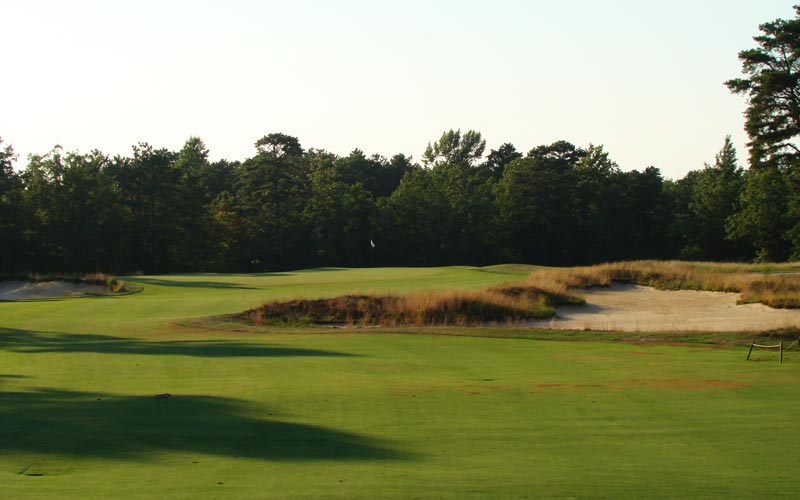
The large bunker that visually dominates the sixth is well forward from the green. Coupled with firm running conditions, the golfer is given plenty of options on how to play his approach shot.
Eighth hole, 330 yards; A multiple route short two shotter with the day’s hole location dictating which side of the central bunker to play. With the hole left, the player should go left off the tee and with it right, the player goes right. Matters are complicated up ahead where a large mound in the green’s center can send approach shots or putts any which way. With the central bunker and the mound in the middle of the green, the architectural merits of placing the challenging features down the center as opposed to on the sides are highlighted as multiple playing angles/strategies unfold. Coore & Crenshaw have devised many, many great short par fours but one element that this one possesses that most don’t is that of mystery. Hopefully, the golfer sees his tee ball vanish over the crest of the hill but then, who knows? How hard did it pitch forward on the downslope? How did it react with the large mound in the green? Perhaps it curled tight to the hole for a short eagle putt? Only after walking 240 yard does the fate of his tee ball become clear to the golfer. Finding ways to create suspense by delay knowing an outcome is a wonderful feature to bring to any course.
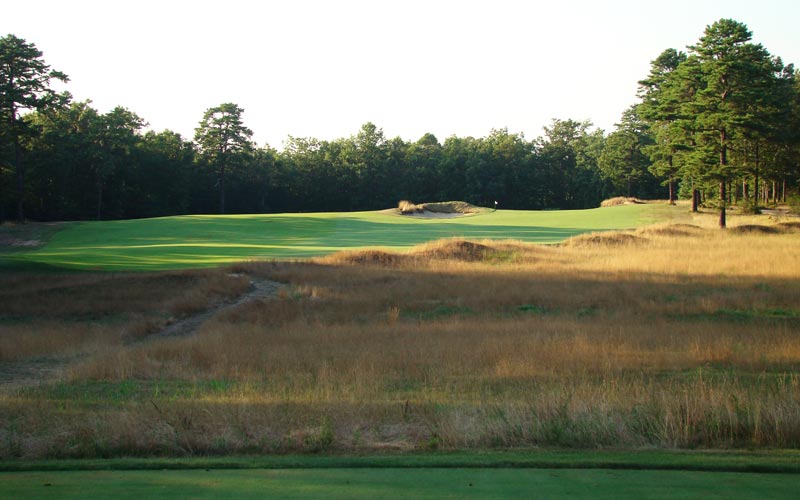
A bunker way right, a bunker in the middle of the fairway, and the top of the flag nestled in its own little dell are what the golfer sees from the tee.
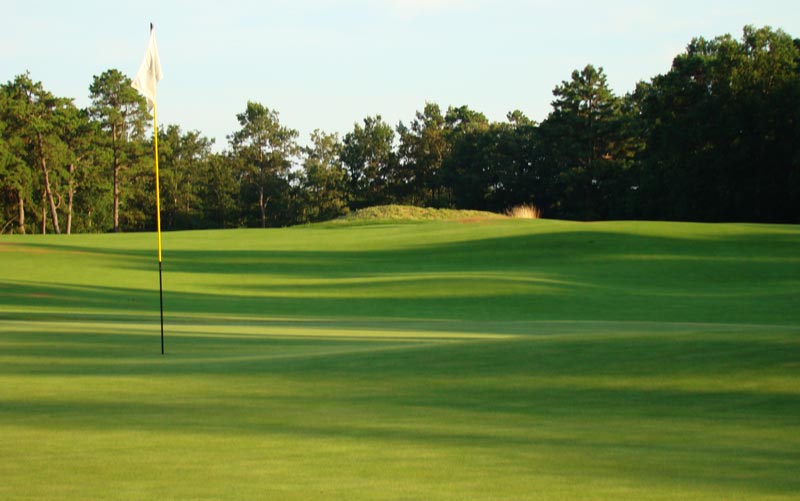
Once past the central hazard, this view from behind the green shows how tee balls receive forward kicks, hopefully onto the rolling green for a putt for an eagle.
Tenth hole, 475 yards; A drive that passes the two bunkers down the right can catch a ‘power slot’ and be propelled well forward toward the green. That’s the good news. The bad news is that the golfer is still left with a long shot into a target that shows very little interest in receiving it! Not unlike the feared tenth at Oakmont, before playing one’s approach, the realistic golfer needs to consider where around the tenth green complex is the best place from which to play his third shot given the day’s hole location.
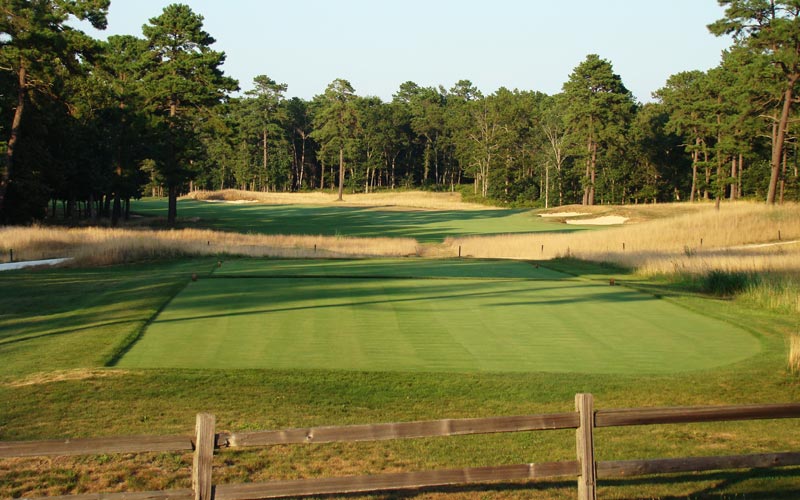
A draw at the two bunkers in the distance gives the golfer his best chance at reaching the green in regulation.

Drapped over the crest of a hill, the fallaway tenth green is an elusive target. Playing long past the hole often times leaves an easier third shot as the golfer can play uphill toward the hole.
Eleventh hole, 120 yards; In the classic Donald Ross give and take mode that make his courses such a delight to play over and over, Coore & Crenshaw constantly mix up the demands of the holes at Hidden Creek. The reachable three shot third is followed by a long and difficult one shotter, the 470 yard two shot sixteenth is followed by another reachable par five and here the tiny eleventh is sandwiched on either side by brutes of golf holes. An absolute charmer, this tiny hole is many people’s favorite on the course.

The eleventh calls for a crisp pitch up the hill to a skyline green, which at 4,400 square feet is the smallest on the course.
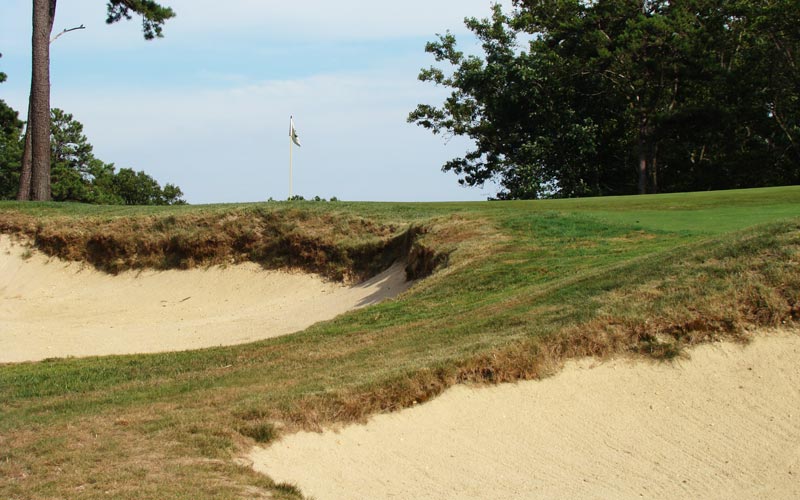
The knob like eleventh green is a hard one to recover to with short-siding yourself a particularly poor idea.
Twelfth hole, 465 yards; Overstating the excellence of Coore & Crenshaw’s routing at Hidden Creek is impossible and it’s highlighted at the twelfth where its fairway effortlessly flows across this rolling portion of property. The tee is on the crest of one hill, the landing area on the broad crest of another, and the green further ahead on yet another. All this makes perfect sense when playing the exposed hole of today yet try finding this playing corridor within 750 acres with the land shrouded in hardwood trees and underbrush! It is the kind of natural hole that was impossible to find on a flat site like Blue Heron Pines.
Thirteenth hole, 390 yards; In contrast with the rolling twelfth, the thirteenth (and fourteenth) are laid across the only flat portion of the property. In addition, the design team elected on this rare occasion to leave the trees close in to frame the green as opposed to having cleared sixty yards behind the twelfth green, for instance. Nonetheless, the hole’s rich composition as provided by the golden fine fescue and numerous bunkers contrasted against the dark green pine trees closely knits the hole into the common fabric of the other seventeen. Why more clubs don’t pursue the vibrant, rustic texture as put forth at Hidden Creek is a mystery. James Duncan sums up its playing attributes well when he writes, ‘Thirteen happens to be one of my favorite holes at HC, and a nice testament to the possibilities of flattish ground. It’s one of Jim Craig’s greens and one of the first he worked on after he got to the project. He came to HC straight on the heels of Chechessee, and I give him a lot of credit for instantly adapting to an entirely different style. The clearing sets up the shape of the hole, with the tight line to the dogleg on the right, and the wide swoop on the left. I remember Ben commenting that Ross used that idea a lot on his courses, and ever since that type of clearing has been a “Ross clear” in my field terminology. The green is superb. While it doesn’t have dramatic elevation changes it is characterized by the way it sits on an angle on a slight rise, relative to the line of play, by a couple of neat internal contours and the absence of any real back to the green. It just sort of drifts off. What I like most about the hole is that it’s not overly exacting or particularly difficult, but intent instead upon providing interest and fun. It has the kind of green that promotes a considerable variety of shots by the simplest of means, which, to our way of thinking at least, is one of the most attractive and elusive patterns of golf course design.’
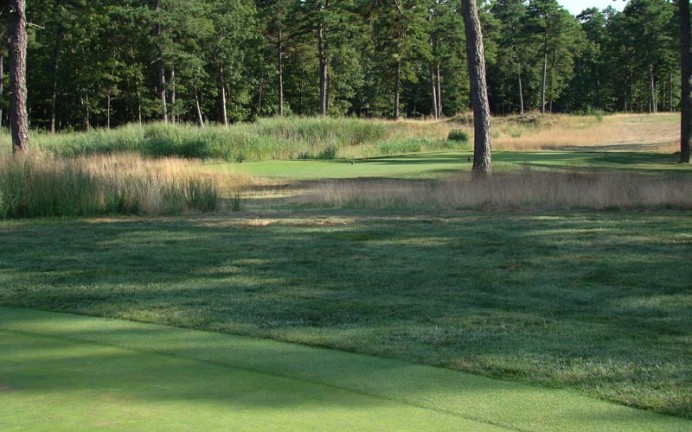
In common with the great heath courses, Hidden Creek can be walked in under three hours, thanks to short green to tee walks such as here from the twelfth green to the thirteenth tee.

Though laid across flat land, the thirteenth is anything but straightforward to play thanks to the numerous fairway bunkers.
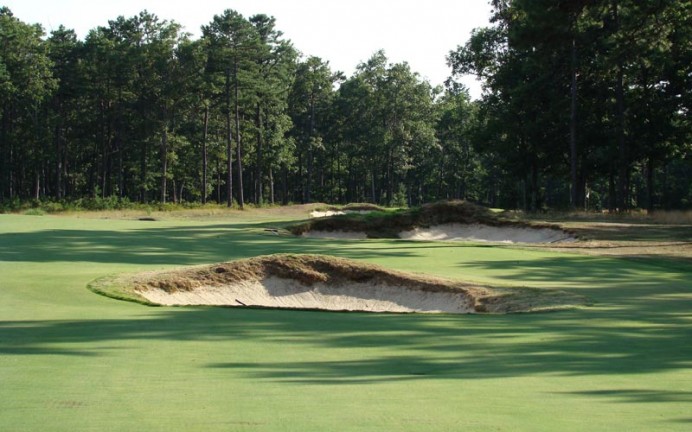
A tee ball that flies this central hazard and skirts left of the second bunker leaves the ideal approach angle.
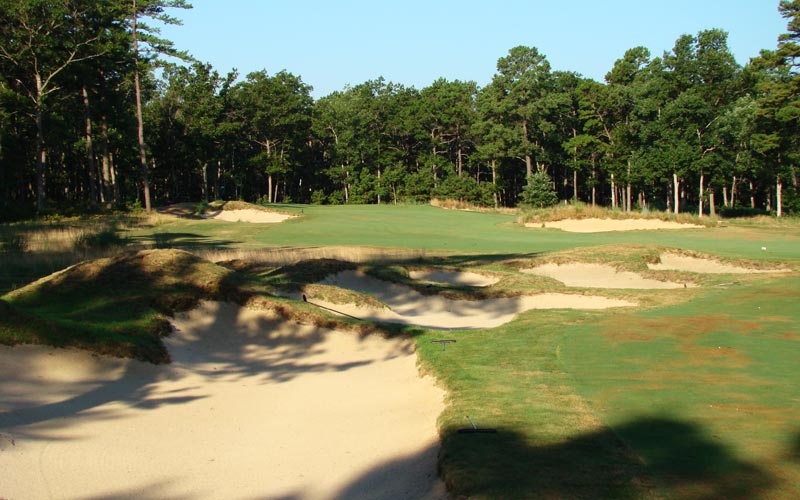
Given that it is over flat land, the golfer isn’t surprised to find that Coore used more fairway bunkers here than on any other hole to give it its playing interest. Eleven of the course’s one hundred and one bunkers are found on the thirteenth.
Fourteenth hole, 200 yards; In an attempt to give every hole immediate visual impact, many modern architects in the past two decades defined the green to such a clear degree that it inadvertently became an easier target. Here, Coore & Crenshaw could have easily highlighted the green through the placement of mounds and bunkers. Instead, they kept the fourteenth green as an extension of the fairway with the green even slightly below its surrounds in spots and no bunkers down its long left side. From the tee, the golfer is hard pressed to determine where on this 51 yard (!) deep green the hole actually is. A simple yet effective hole where the architect didn’t get in the way of himself. The less is more principle applied here helps reinforce that the ground is one’s friend at Hidden Creek.
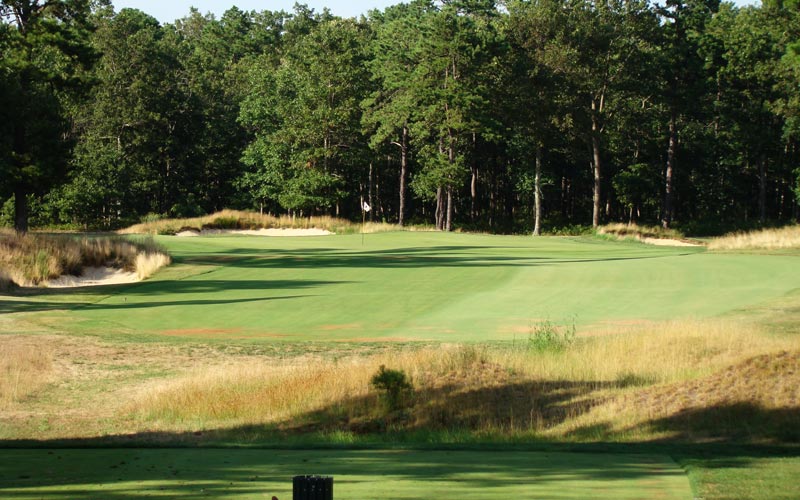
In a fine change up from the heavily bunkered hole prior, the simplicity of the fourteenth adds to the overall variety of the course.
Fifteenth hole, 410 yards; Harry Colt had a remarkable ability for knocking quality into each hole at his famous heathland courses around London. Be it St. George’s Hill or Sunningdale New or Swinley Forest, all the holes have something to recommend for themselves as the golfer is always given something to try and accomplish. Here the art form of shaping shots is alive and well with a draw ideal from the tee and a green that sets up perfectly for a fade.
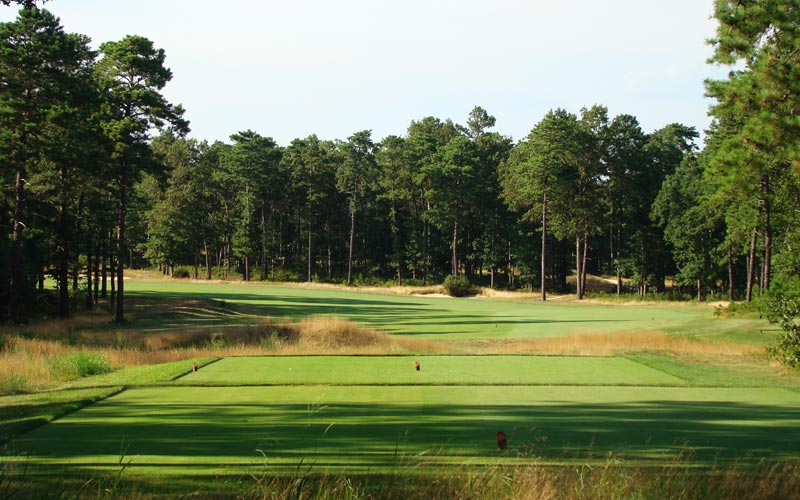
The downhill fifteenth bends left at the 250 yard mark. The golfer who starts a draw at the scotch broom hanging over the bunker on the outside of the dogleg ….
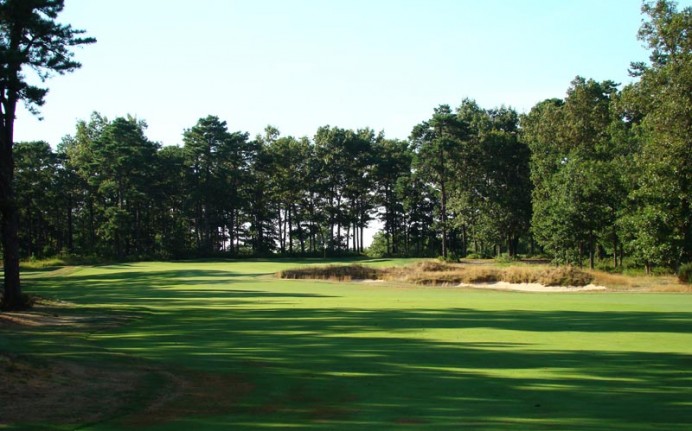
…gains the best angle and shortest distance into the elevated green.
Sixteenth hole, 470 yards; Just as no two Coore & Crenshaw courses look alike, no two holes at Hidden Creek look alike either, which is no mean feat for property that isn’t dramatic. In fact, the only knock on the once excellent Pines Course at nearby Seaview Country Club was that one had trouble recalling the specific holes after the round. Not so at Hidden Creek. In the case of the sixteenth, it is made memorable and unique by a diagonal row of irregular mounds that bisect the fairway and by Jim Craig’s vexing green with its high point in the middle. Ian Dalzell describes the sixteenth as ‘perhaps the tightest tee shot on the course, particularly for the longer hitter as the fairway pinches in at around the 240 yard mark. A wide sweeping cut was made on the tree clearing on the left whereas the tree line is fairly straight up the right side of the entire hole. The hole is bisected by some large fescue-laden mounding running straight across the fairway 295 yards from the tee. They were placed there for functional reasons during construction due to the low and wet nature of the soils. Today they play havoc with the player who has missed the fairway and is simply trying to punch out and advance his ball. Bill and Ben love to deceive the eye, making you question yourself as you stand over the ball. Here on 16 they did a nice job of that by placing a large skinny bunker that runs some 90-yards up the right of the final 120-yards of the hole. It looks much smaller, which in turn seemingly brings the green closer to your eye and approach shots inevitably come up short.’
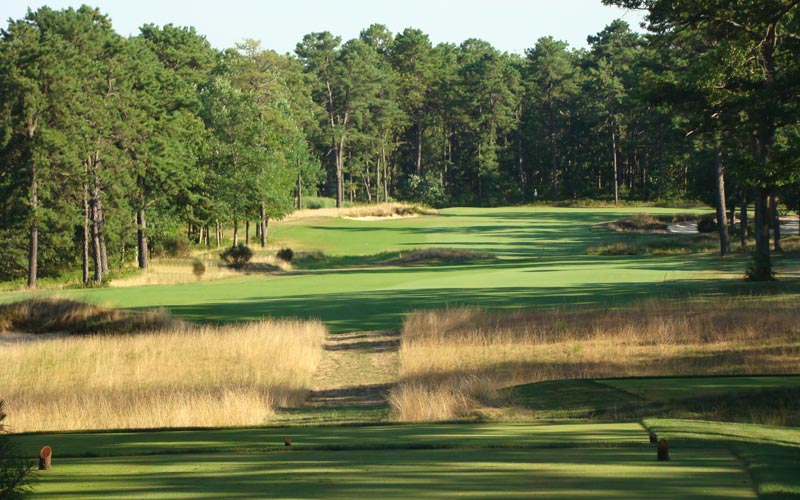
Irregular shaped mounds diagonally bisect the sixteenth fairway at the 295 yard mark from the tee. Creating such mounds without any hint of symmetry is a genuine art form.
Seventeenth hole, 530 yards; The drama that has unfolded for decades on the seventeenth at Muirfield in Scotland epitomizes the virtues of having a reachable three shotter late in the round, and this hole has similar qualities to help see-saw many a match. In a nice touch (the kind of touch that only occurs when the architect is on site for an extended period of time), a knob near the front left of the green was created that sometimes helps deflect a running approach shot toward the putting surface.
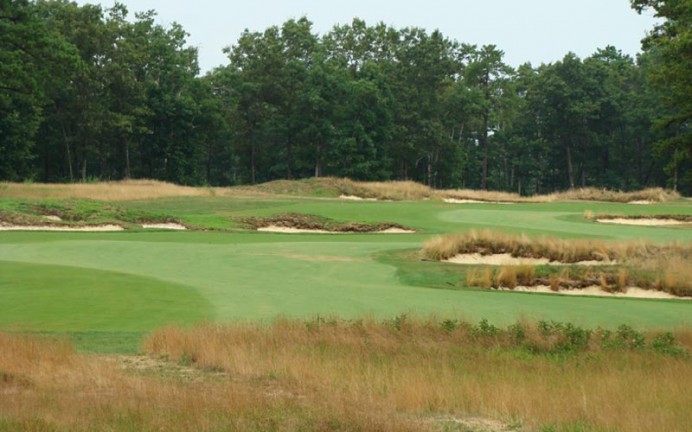
The golfer who can avoid the array of bunkers down the seventeenth fairway has a chance to pick up a shot on Old Man Par.
Since opening in 2002, Coore & Crenshaw continue to work closely with the Club in making sure that the holes play as they were intended. For instance, the second, eighth, seventeenth and eighteenth tees have been extended back so that the central hazards/ridges remain integral to the playing strategy of each hole. At the same time, new forward member tees have been added at the sixth, tenth and sixteenth holes. These three holes remain very tough but at least the holes are now within reach of the typical member. After all, the purpose of Hidden Creek from day one has been always about enjoyment and variety as opposed to sheer length and difficulty. Credit both the owner for wanting – and the architects for delivering – such a course. In every meaningful respect, it is an ideal course upon which to enjoy a game on a frequent basis. As Dave Axland noted during his last visit from Friar’s Head, ‘Boy, something really went right here.’
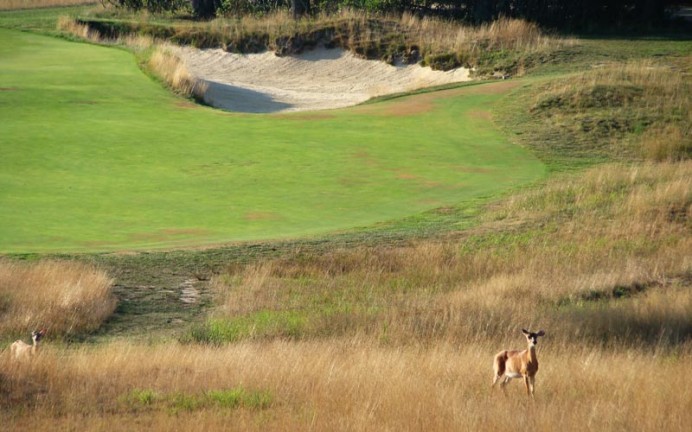
Both golfers and deer enjoy the tranquil atmosphere at Hidden Creek.
The End


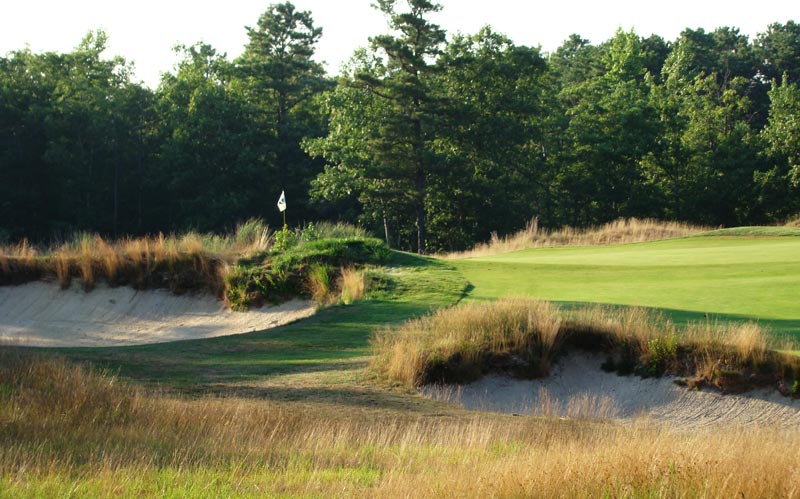

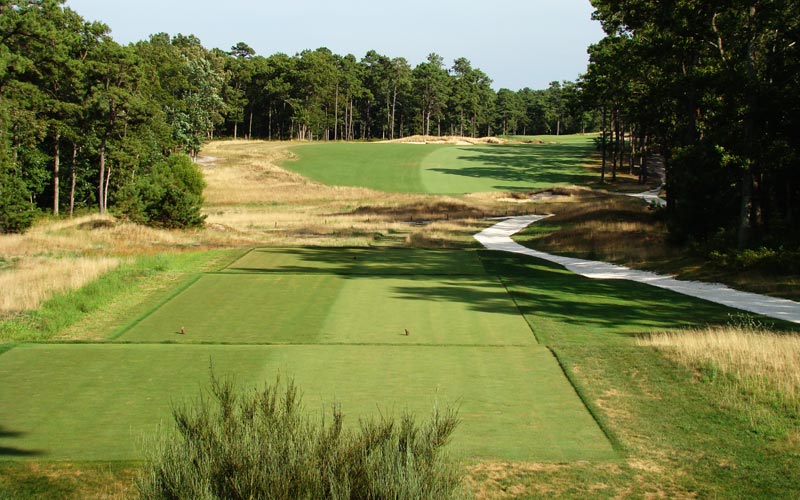
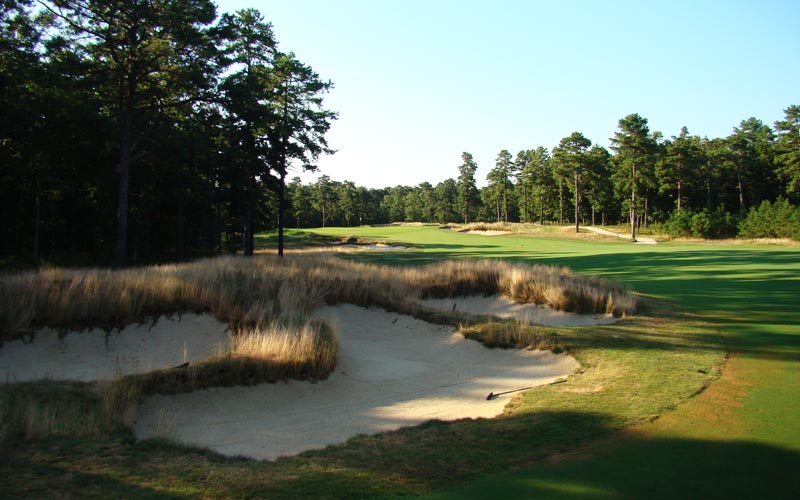



![The Park, West Palm (Lit 9) [2023]](https://golfclubatlas.com/wp-content/uploads/2024/12/IMG_7092-2-scaled-500x383.jpg)


